Plug in and stay connected at all times while you are on the road with our top choices for the best RV inverters.
Inverter technology allows your RV to convert direct current to alternating current, or vice versa.
This is important because not all of the appliances in your RV require the same type of current to operate efficiently.
Back in the days of Thomas Edison and Nikola Tesla, there was a great debate between the pros and cons of alternating and direct current. We’ll cover some of the basic differences later in the Buying Guide.
Most RV owners probably don’t spend much regular time even thinking about the inverter in their rig.
It’s one of those pieces of technology that largely does its job in an unheralded fashion until something goes awry.
An RV inverter has its best use when your rig isn’t plugged into an AC electrical connection. The inverter will convert the DC input of your RV’s battery bank to a stable AC output that you’ll need to keep the essential appliances and electronics in your RV running.
If you find yourself in the position of needing a new power inverter for your RV, you’re probably finding a lot of options.
Thankfully, I’ve done the research for you so you can use this article to choose the best RV inverter for your needs.
In addition to reviewing several different types of RV inverters and suggesting their best use, I’ve also added a comprehensive buying guide below.
This guide includes everything you need to know to understand RV inverters and choose a model that’s compatible with your RV.
The 10 Best RV Inverters Of 2024 : Reviews & Recommendations
In this article, I’ve chosen 10 of the best RV inverter models and separated them into four categories.
Within each category, I’ve also labeled the inverters by their best use, according to their features, specifications, and user reviews.
So let’s get into the list of our recommended power inverters for RVs and Camper vans including important specs and detailed reviews.
Pure Sine Wave Inverters
1: Best Overall: AIMS Power 2000 Watt 12V Pure Sine RV Inverter
The AIMS Power PWRI20012120S is the best pure sine wave RV inverter choice for anyone that needs a high level of surge protection and ample continuous power. It is rated to handle 2000 running watts and 4000 starting watts.
This pure sine wave RV inverter also provides a clean, consistent flow of power from your RV battery to the outlets and appliances that require alternating current (AC).
It is also designed to provide protection against overheating, short circuits, high and low voltages, overload, and a host of other potential issues.
Most RVs won’t require much more than 2000 watts of continuous power when you aren’t plugged into a power stand.
Although it might not be enough to power your RV air conditioning unit if you’re not plugged in, this inverter provides enough power capacity for the other essential appliances in most RVs.
I also like that this inverter comes with an optional remote switch (that must be purchased separately).
Because you’ll probably install it somewhere in your RV that you don’t necessarily frequent every single day, it can be an added bonus to have remote control over the inverters On/Off function.
Things We Like
Things We Don’t Like
2: Best For Easy Installation: Go Power! GP-MS2812-PKG 2800 Watt Pure Sine Wave
If you’re looking for an RV inverter that’s going to be easy to install, check out the Go Power! GP-MS2812-PKG inverter.
It easily wires into your RV’s battery and includes a built-in charger and transfer switch.
That transfer switch easily allows you to switch from shore power to battery power or generator power.
This inverter provides 2,800 watts of continuous power and up to 3,900 peak watts.
Its 12 volts of direct input current to 120 volts of alternating output current and provides a peak output up to 70 amps.
When you need to turn this inverter off, you’ll easily be able to do so using the included remote control with this inverter.
It also has a visual control panel that displays critical performance and maintenance information so that you can keep track of when it’s time to service your inverter.
Wiring issues can plague even the best inverters, which is why I like that this one uses an FBL-400 slow blow Class T inverter fuse to protect your wiring and the inverter itself.
Perhaps best of all, this inverter is backed by a three-year warranty that includes both parts and labor, so you can rest easy knowing that the manufacturer stands behind its product.
Things We Like
Things We Don’t Like
3: Best For Solar Setups: WZRELB Reliable 3000W Pure Sine Wave Solar Power RV Inverter
For those that want to improve the solar capacity of their RV, the WZRELB 3000 Watt Solar Power Inverter is a great option.
This inverter is rated for 3000 running watts and 6000 peak watts and it includes two 120-volt GFCI outlets on the side.
Multiple models are available that are designed for 12, 24, or 48 volt DC inputs.
The extra thickness (2.00 millimeters) of the PCB used in this inverter helps to increase its overall load capacity and the high-frequency transformer seamlessly transfers DC to AC while ensuring complete and stable delivery of AC current to your RV’s appliances.
I like that this inverter has an LED display on the side as well. This displays both DC and AC power usage so that you can better monitor your current draws when running various RV appliances.
I also love the protections of this inverter. It’s built automatically cut off high voltages, sound an alarm when dangerously low voltages are detected, and provide overload and over current protection.
It also features a silent cooling system that keeps the inverter from overheating without causing annoying noise.
Things We Like
Things We Don’t Like
Portable And Compact Inverters
4: For Charging Electronics: Cobra 1500 Watt Portable Power Inverter For RV
If you’re looking for a portable power inverter for your rv that can charge multiple electronics while you’re driving, you’ll like the Cobra CPI1590.
This inverter includes a total of three grounded AC outlets that allow you to charge up to three small appliances or electronic devices at a time while you’re driving.
I like that it includes an LED screen that allows you to monitor up-to-date battery voltage and the current consumption for all connected devices and appliances.
It also features a total of five levels of protection to keep this inverter from overheating or sustaining damage from low and high voltages and reverse polarity.
This inverter also includes a 2.4 amp USB port for charging an additional device while you’re on the go.
As a compact inverter, the Cobra has dimensions of 9.25 inches long by 8.75 inches wide by 3.25 inches long. It also weighs less than four pounds, which is super lightweight for an inverter.
This Cobra model doesn’t have the highest ratings for continuous power and peak watts, but it’s rated for 1,5000 watts of continuous power and up to 3,000 peak watts.
For those that are more careful with the energy consumption in their RV, this inverter will provide plenty of power.
Things We Like
Things We Don’t Like
5: Best with Remote Control: Ampeak 2000 watt power Inverter
For those that want to retain remote control functionality with a more compact power inverter, the Ampeak 2000 Watt Inverter comes with a remote switch that allows you to turn it on or off without having to go directly to the unit itself.
It’s also rated for substantial power up to 2,000 watts of continuous power with a 4,000-watt surge capacity.
You’ll be able to plug in up to four different appliances or electronics to this inverter. It has three grounded AC outlets and one 2.1 amp USB port for smaller electronics.
I like that this inverter has audible alarms to alert you to high and low voltages, short circuits, overheating, and overloads.
Because you won’t always be visibly monitoring your inverter, it’ll be nice to have audible alerts if anything isn’t quite as you’d hope it be with your inverter.
This portable RV inverter is also built with ABS technology to improve its durability and resistance against vibrations while you’re on the road.
The ABS plastic shell also improves the electrical insulation of this inverter to protect its components.
Things We Like
Things We Don’t Like
6: For Most Appliances/Devices: POTEK 3000 Watt 4 AC Outlets with 2 usb port
For those that have a lot of appliances or devices that they need to plug into their inverter, the POTEK 3,000-Watt Inverter is a great choice because it has multiple outlets and ports.
There are four grounded AC outlets and two USB ports on this inverter.
This inverter is rated for 3,000 watts of continuous DC to AC power and up to 6,000 watts of surge capacity.
It also has multiple levels of protection, including against high and low voltages, short circuits, overheating, and overloads.
If you live in a warmer climate, this inverter might be a good option because it includes two intelligent cooling fans that have smart sensors to keep the inverter’s working temperature at a reasonable level.
It has an operating ambient temperature range from 32 up to 104 degrees Fahrenheit.
I also like that this inverter includes Surface Mount Technology that provides more efficient power and fewer stray RF emissions.
This technology also allowed the manufacturer to reduce the weight of this model by 36 percent and the overall size by 28 percent, when compared to previous models.
Things We Like
Things We Don’t Like
Best Modified Sine Wave Inverters
7: Best For Battery Protection: Xantrex Inverter/Charger Freedom 458 2500 Watt
If you go for a modified sine wave inverter with ample protection for your RV’s deep cycle batteries, the Xantrex Freedom 458 inverter is a great option.
It has temperature control charging which provides optimal recharge for your RV’s deep cycle batteries.
To protect the inverter from incurring larger damage, it has an automatic shutdown feature if excessive temperatures, short circuits, or other electrical issues are detected.
It also has a power-sharing feature that serves to prevent the source AC input breaker from tripping and causing damage to your inverter.
I also like that this inverter offers multistage charging which is able to recharge your batteries more quickly than other inverters.
It comes with a basic remote switch that allows you to turn the inverter on or off without requiring direct access to the unit itself.
The Xantrex Freedom is a more expensive model when compared with other inverters, but it does come with a built-in transfer switch that automatically detects shore power and controls whether your RV is utilizing shore power, battery power, or generator power.
Things We Like
Things We Don’t Like
8: Best with Wired Remote Control: Krieger 4000 Watt Modified Sine Wave inverter
For a modified sine wave inverter with a wired remote control, check out the Krieger 4,000-watt inverter.
This RV inverter provides a lot of power and is rated for 4,000 watts of continuous power and up to 8,000 peak watts.
It has an LCD display that will give you current information on input voltage, output wattage, and battery level.
It also includes a thermal cooling feature that guarantees ultra-silent operation so you’ll hardly notice it running.
This inverter comes with a wired remote control so that you can turn it on or off without needing direct access to the inverter.
The inverter has temperature protection so that it will automatically shut down if the internal temperature threshold is reached. It will also shut down if a short circuit or overload is detected.
I also like that this inverter weighs less than 10 pounds and comes with an ANL inline fuse kit.
It also comes with three feet of battery cables and a built-in hardwired kit that will work for applications greater than 15 amps.
If anything goes wrong, you can also rest assured that this inverter is backed by a three-year warranty on parts and labor.
Things We Like
Things We Don’t Like
Heavy Duty Inverters
9: Best 36-Volt DC Input: WZRELB 6000 Watt Continuous Power Pure Sine Wave Inverter
If you’re interested in a heavy-duty inverter for your RV that requires a 36-volt DC input, here’s the WZRELB 6,000-Watt continuous power.
This inverter is rated to provide 6,000 watts of continuous power and up to 12,000 peak watts.
It also comes with two sets of battery cables and several fuses to help with the installation process.
The PCB board on this inverter is extra-thick (2.0 millimeters), which helps to increase load capacity and safeguard the inverter’s internal components. It also helps to ensure a more stable and full AC output.
The WZRELB 6,000-watt inverter has a total of four 120-volt AC outlets for plugging in larger RV appliances.
It also boasts soft start technology to reduce the likelihood of blown fuses or popped breakers.
If the inverter detects electrical issues, such as short circuits or overheating, it will automatically shut down and only restart automatically when issues are no longer detected.
For me, the most important feature of this RV inverter is the high continuous and peak power ratings.
These ratings make it ideal for RV owners that need to power large air conditioning units that require high starting wattages.
Things We Like
Things We Don’t Like
10: Best For High Surge Capacity: Wagan EL3746 8000 Watt Power Inverter for camper Van
If you’re intrigued by an RV inverter that has one of the highest surge capacities on the market, don’t overlook the Wagan EL3746 inverter.
It’s rated for 8,000 watts of continuous power and up to 16,000 peak watts. It’s also more than 50% smaller and lighter than previous Wagan models.
It also comes with a remote power switch that allows you to operate the On/Off switch from a remote position.
This inverter’s built-in safety features help to protect it against damage that can be caused by a low battery, short circuits, reverse polarity, overheating, and overloading.
Although it does rely on a modified sine wave output, this inverter uses integrated Surface Mount Technology (SMT) circuit boards.
This technology provides more reliable and efficient power while also reducing stray RF emissions.
When you’re hooking this inverter up to your battery, you’ll love the heavy-duty solid mount terminals that allow for easy installation.
It also features an LED light that alerts you to the presence of electrical issues, includes four grounded AC outlets, and is backed up a 24-month warranty.
Things We Like
Things We Don’t Like
How To Choose The Right Inverter For Your RV
Now that you’ve looked through ten options for the best RV inverter, it’s time to get into the criteria you should use to make your selection.
In this Buying Guide, we’ll cover inverter types, how to estimate your wattage needs, the differences between AC and DC, and more!
Inverter Types
RV inverters can typically be broken down into three categories. These categories refer to the type of waveform the inverter provides, so we’ll take some time here to discuss the advantages and disadvantages of each type.
1: Pure Sine Wave Inverter For RV
This is a very common type of RV inverter because most of the power supplied by your generator or local utility company arrives in the form of a pure sine wave.
The major benefit of a pure sine wave inverter is compatibility with almost any RV appliance currently on the market today.
Pure sine wave inverters are capable of supplying effective, efficient power to all of your RV appliances. This type of inverter will allow your appliances to function to the fullest extent of their specifications.
Certain appliances in your RV will only work with pure sine wave power. Some common examples include your microwave and motors for central heating systems.
These are important appliances that should always be supplied with enough power to function efficiently.
There are also other appliances that require pure sine wave power to operate. But the only downside of this type of inverter is cost.
Pure sine wave inverters tend to cost two or three times more than other types, but they’re almost always worth it because of the efficiency of the power they supply.
2: Modified Sine Wave
Modified sine wave inverters work with most RV appliances but they often supply reduced (or less efficient) power to those appliances.
Because modified sine wave inverters are less efficient, appliances that use motors will consume more power from this type of inverter.
In some cases, the motors on your RV’s refrigerator, fans, or water pump can consume up to 20 percent more power from a modified sine wave inverter than they would consume if power is being supplied by a pure sine wave inverter.
Another drawback of using a modified sine wave inverter is reduced brightness for your cabin lights. This can especially be true if you’re using fluorescent lights in your RV.
Because of the decreased efficiency of a modified sine wave inverter, you might also hear the fluorescent lights in your RV making a buzzing or humming noise.
Speaking of noise, modified sine wave inverters tend to be louder than pure sine wave inverters. This can require a period of acclimation as you get used to falling asleep to the sound of your inverter humming.
If efficiency isn’t super important to you (and you don’t mind the extra noise), a modified sine wave inverter can still provide capable power for your RV’s outlets and appliances.
This type of inverter is also generally much less expensive than comparable pure sine wave inverters.
3: Square Wave
Square wave inverters are by far the most cost-effective inverters on the market. That being said, they’re also significantly less effective for RV use.
This type of inverter can only power simple things without issues. For example, tools with universal motors work well when supplied power from a square wave inverter.
But most RVs and their appliances require a more complex power supply than a square wave inverter can provide. That’s why you don’t see many square wave inverters advertised for RV use.
Alternating Current and Direct Current
Alternating and direct current describe two different flows of current in an electrical circuit.
In order to better understand why you need an inverter for your RV, I think it’s best to have a more complete understanding of these two types of current and how an RV inverter works with both of them.
In short, an inverter is necessary to convert direct current to alternating current. The batteries in most RVs will supply DC power when you’re not plugged into an electrical stand. But you’ll need an inverter to convert that DC power to the AC output that is required by most of your RV appliances and electronic devices.
But let’s get into a brief history of these two currents as well.
In the late 1800s, we hadn’t yet figured out how to convert direct current (DC) to high voltages. Due to this limitation, Thomas Edison proposed a series of local power plants to provide power to individual neighborhoods or sections of a city.
While this would work in most urban settings, others realized that it would be incredibly inefficient to supply power to more remote areas of the United States.
Using Nikola Tesla’s patents for alternating current (AC) motors and transmission, George Westinghouse began working to perfect an AC distribution system.
Using transformers, they were able to step up AC voltage across power lines (still used in the U.S. today) and then step the current back down for safe usage.
In 1896, George Westinghouse completed a project to construct a hydroelectric dam on Niagara Falls that allowed them to supply the entire city of Buffalo, New York with AC power.
This marked a decline in DC usage in the United States, but the two currents are still in use today.
It is because of the fact the different electronics require different currents that we need inverters in an RV.
Most RV inverters change 12-volt DC power to 120-volt AC power, which is what is required by cell phones, microwave ovens, and most other essential appliances.
Understanding Your Wattage Needs
If you always plan to plug into an electrical stand in an RV park or resort, you’ll have much less need for an RV inverter because you’ll most certainly be working with a 120-volt AC power supply.
However, if you ever want to camp off-grid for a few days at a time, you’ll need an inverter to power the appliances that you deem essential.
For example, your off-grid camping needs might require you to run your air conditioning unit for at least two or three hours a day.
If this is the case, the inverter you choose must be capable of handling the starting and running wattage of your A/C unit.
Your air conditioning unit typically pulls the most wattage of all the appliances in your RV, and its rating for starting watts will likely be higher than its rating for running watts.
So be sure the inverter you choose can handle your A/C units needs for starting watts if you plan to use your A/C off-grid.
Additionally, you should keep in mind that you might not run your air conditioning unit by itself at all times.
You might need an inverter that can handle your A/C units running watt draw as well as the draw of your phone charger at the same time.
While it’s not recommended to run all of your RV’s appliances at once, you should keep this idea in mind when deciding how on the minimum wattage rating you need from your inverter.
Power Rating
An inverter’s power rating is typically specified in wattage. But it’s important to note that most inverters will be rated for continuous power and peak watts.
You’ll sometimes see manufacturers use the terms ‘peak watts’ and ‘surge capacity’ interchangeably.
An inverter’s rating for continuous power will be a lower wattage than its rating for peak watts or surge capacity.
However, you should recognize that these ratings aren’t always thoroughly tested and the actual functionality of an inverter can depend on the wattage needs of the appliances in your RV.
When evaluating how much power an inverter is capable of handling, it really pays to read further into user reviews to gather more data on how various inverters handle different loads.
You should also pay close attention to an inverter’s maximum surge capacity. The hard part about this rating is that there’s no universal definition for the duration of a power surge.
Some surges can last seconds while others can last much longer. When you see an inverter’s surge rating, it typically means it can handle that wattage for several seconds.
The important thing to remember is that some inverters that can handle a large surge for several seconds might not necessarily be able to handle that wattage over a sustained period.
This is one of the important reasons why most inverters have built-in safety features that will automatically shut them down when dangerous high voltages are detected.
Input and Output Voltage
An inverter’s input and output voltage are important specifications to pay attention to as well. When it comes to these specifications, the output voltage you should look for will be a bit simpler than input voltage.
Most appliances and electronic devices throughout the United States, Canada, Mexico, and certain parts of Central and South America utilize 120-volt AC power.
If this is the case with your electronics and appliances, you’ll need to make sure to choose an inverter that offers a 120-volt AC output.
That being said, there are certain appliances and devices out there that require other output voltages to charge or operate efficiently.
Make sure to understand the AC voltage requirements of your appliances and electronics before selecting an inverter with a certain output voltage.
When it comes to the input voltage, the rating you need to look for should correlate with the battery (or batteries) in your RV.
Most RVs use 12-volt DC batteries, but there are also 24-volt, 36-volt, and 48-volt batteries out there. And those aren’t the only battery sizes you could have installed in your RV.
Your inverter needs to be able to handle the input voltage coming from your battery and invert that voltage to the required output voltage needed by your appliances and electronics.
The most common scenario is an inverter that converts 12-volt DC input to 120-volt AC output, but there are plenty of other options out there.
Energy Efficiency
The energy efficiency of an inverter should also be considered because it will impact the efficiency of your system as a whole.
An inefficient inverter will sometimes overtax your RV batteries and under-deliver power to your appliances and devices.
An efficient inverter shouldn’t drastically increase your overall energy consumption. That said, it’s important to find an inverter that offers a balance between energy efficiency and the ability to provide stable, reliable power.
Onboard Battery Bank Capacity
The battery bank capacity of your RV is largely responsible for how long your equipment and appliances will be able to run without AC power.
When you aren’t running on AC, you’ll be utilizing the DC power from your battery bank, which will slowly deplete until you run the engine or plug into an AC electrical stand.
The length of time your equipment can run on DC power will also play a role in your inverter selection because a less efficient inverter will deplete your battery bank capacity more quickly.
This really turns into a larger problem if you like to live off-grid for the majority of your time in your RV.
For those that feel comfortable frequently running their engine to recharge their battery bank, a small inverter will likely suffice.
But those that plan to require a stable supply of DC power for extended periods should consider purchasing a larger inverter.
So, Which Is The Best Power Inverter For RV?
I realize that I’ve included a lot of RV inverter models and quite a bit of buying information in this post.
So, in the interest of giving you some guidance that might feel a bit more inclusive, I’ve included these quick breakdowns of who might be best served by each of the RV inverters I reviewed above.
The AIMS Power PWRI20012120S RV Inverter got my vote for the best overall RV inverter for anyone in need of a new device. If you want an inverter that provides good continuous power, ample surge protection, and fits within your budget, definitely check this one out.
If you’re looking for an inverter that offers one-time, easy installation, check out the Go Power! GP-MS2812-PKG inverter.
Install it closer to your RV’s battery bank to avoid voltage loss, but the installation process for this inverter should be clear and simple, as long as you follow the manufacturer’s recommendations.
If you have solar panels already set up on top of your RV and need an inverter to complete your installation, the WZRELB 3000 Watt Solar Power Inverter is a great option.
This inverter uses a high-frequency transformer to deliver a stable AC output from the energy your panels convert from the sun.
Those that like to charge their electronics while road tripping should consider the Cobra CPI1590.
If this is your desired application, this inverter can be installed within easy reach of your captain’s chair and has two GFCI 120-volt outlets and one USB port for charging your devices.
The Ampeak 2000 Watt Inverter is a more compact inverter for anyone that doesn’t have a lot of space in which to install a new model.
It also includes a remote control switch that allows you to turn it on or off without having to go directly to the unit itself.
If you have four or five appliances or devices that you need to plug directly into an inverter, the POTEK 3,000-Watt Inverter is a great choice because it has multiple outlets and ports.
It offers a total of four 120-volt AC outlets and one USB port.
Those concerned with finding an inverter that can precipitate safe and fast recharge of their RV’s deep-cyle batteries should consider the Xantrex Freedom 458 inverter.
This is a modified sine wave inverter that has various temperature regulated features to both protect your batteries and ensure fast, efficient recharges.
The Krieger 4,000-Watt Inverter is a useful modified sine wave inverter that comes with a wired remote control.
It’s also a good choice for those with larger appliances that require up to 4,000 maximum watts of continuous power.
If you’re interested in an inverter that can convert a 36-volt DC input to a 120-volt AC output, head back up to check out the WZRELB 6,000-Watt Continuous Power Inverter.
This is also a handy inverter for larger RVs with multiple air conditioning units that require higher peak wattage.
If you’re simply looking for the RV inverter on my list that offers the highest surge capacity, you’re looking for the Wagan EL3746 inverter.
This inverter is rated to handle up to 16,000 peak watts and also comes in a package that is more than 50 percent smaller and lighter than previous Wagan models.
Frequently Asked Questions
In case there’s any confusion remaining, there are a few more stones we can overturn with this article.
In this section, I’ll be addressing some of the most frequently asked questions about RV inverters.
What Size Inverter Do I Need For My RV?
This depends on how much you plan to use it, and for what applications. While it doesn’t make sense to spend extra money on an inverter that supplies more wattage than you need, the more important issue to look out for is buying an undersized inverter that can’t supply enough power.
Sizing up an inverter for your RV requires an understanding of your RV’s wattage needs. The easiest way to determine your wattage needs is to assess the power specifications of your RV’s largest appliances, such as your air conditioning unit and refrigerator.
Adding up the wattage required for running these large appliances will give you a minimum threshold of the amount of power you’ll need to operate them when you’re not plugged into AC power.
You’ll then be able to find an RV inverter that’s rated to provide more than that minimum wattage you just determined.
It’s also important to note that there are two wattage ratings to pay attention to on an inverter.
The rating for continuous power an inverter can supply correlates to the “running wattage” of your appliances. An inverter’s surge capacity rating correlates to the “starting wattage” required by your appliances.
Do I have to turn my inverter on and off?
In most RVs, plugging into an AC power source automatically charges your rig’s onboard batteries. These batteries are what supply power to your inverter.
In the absence of an AC power connection, your inverter can sometimes drain your battery charge if not turned off when unnecessary.
Although most RV inverters today are highly efficient so that they don’t draw too much power from your batteries when you don’t need it, you can certainly benefit from turning your inverter off when you’re not living in your RV, or when your inverter isn’t required to supply power to any essential appliances.
The amount of power that an inverter will draw on a daily basis will vary depending on the model. Some inverters can draw up to 24 amps per day, which is actually quite high if you don’t need that much power.
Fortunately, many modern RV inverters come with a remote On/Off switch that’s either standard or an optional addition.
This is a useful feature if your RV sits plugged in for months at a time, without the required functionality of your inverter.
Is it possible for an RV inverter to wear out?
Unfortunately, yes. You’ll start to realize that something might be wrong with your RV inverter if you notice power interruptions, excessive discharge of your RV batteries, or complete failure of the unit to provide power when you’re not plugged into an electrical stand.
Improper installation is one of the most common causes of inverter failure.
This happens when new owners don’t carefully follow all installation instructions or employ the services of an experienced RV electrician.
Other causes of inverter failure include installing incorrect parts, including cables, in line fuses, and gauges.
Again, this is usually a result of user error or a failure to follow manufacturer recommendations.
What are some common issues with RV inverters?
Let’s start with the issue of too much wear on the inverter’s capacitor. Regardless of the current level of the inverter’s input, its capacitors work to supply a consistent level of power output. Because they are a mechanical part, however, capacitors have a limited lifespan.
They can simply wear out over time and can also fail as a result of temperatures rising or dropping past the recommended operating temperature range.
Regular maintenance is a great way to extend a capacitor’s lifetime. Replacing them regularly is also a way to avoid capacitor wear from impacting the function of your entire inverter.
Another common issue with RV inverters is overuse. Each inverter comes with specific recommendations for its operating limit.
These recommendations should be followed carefully to avoiding subjecting the inverter to overuse.
Running your inverter above its limit rating can result in a reduced lifespan or complete inverter failure. Be sure to check that you’re operating your inverter correctly to avoid overuse.
The last common issue I want to mention here is associated with ultrasonic vibrations. These vibrations put mechanical stress on an inverter and can also trigger friction.
This friction, in some cases, will create enough heat to damage the components of an inverter.
Regular maintenance is the best way to avoid this common issue. Electrical connections can loosen or corrode over time.
When this happens, more friction is likely from vibrations. So regularly checking the connections on your inverter for wear and tear is the best way to avoid damage from ultrasonic vibrations.
How do I install my new inverter?
The exact answer to this question, of course, depends on the model that you choose and the RV you own.
If you don’t already know where it is, start by locating the existing inverter in your rig. Looking at your existing inverter should give you a good idea of where and how to install your new one.
If you choose to go with a small inverter that simply plugs into the cigarette lighter, then you can probably already guess how to install it. But larger units will need to be wired directly to your RV’s battery bank.
Installing an inverter closer to the battery means that you’ll lose less voltage. You’ll also need to consult the inverter’s manual for the recommended wire size.
Always go with the recommended wire size in the manual, rather than opting for a smaller size.
Once the inverter is hooked up to the right battery, it must also be connected to your RV’s AC distribution box.
In most cases, this is done through the transfer switch that controls whether the RV utilizes shore power (i.e. from an electrical stand) or battery power.
Some owners may choose a cheaper method of installation. This method requires running an extension cord from the inverter into the RV.
From here, you can simply plug into the appliance you want to run using the battery/inverter setup.
This is an easier method of installation, but it’s less efficient and convenient than wiring directly to your RV’s AC distribution box.
RV Inverter: What is an RV inverter and how does it work?
An RV inverter is a device that converts direct current (DC) power from your RV battery to alternating current (AC) power. This allows you to use AC appliances in your RV, even when you are not connected to shore power.
RV inverters work by taking the DC power from your battery and converting it to AC power using a process called rectification. Rectification is the process of converting AC power to DC power, so the opposite process is also possible.
The AC power from the inverter is then available through the inverter’s AC outlets. It is important to note that an RV inverter does not generate power; it simply converts it from DC to AC.
RV Power Converter: What is an RV power converter and how does it work?
An RV power converter is a device that converts 120-volt AC power from shore power or a generator to 12-volt DC power for your RV’s appliances and accessories. It also charges your RV’s battery bank.
RV power converters work by taking the 120-volt AC power from shore power or a generator and converting it to 12-volt DC power using rectification. Rectification is converting AC power to DC power, so the opposite process is also possible.
The 12-volt DC power from the converter is then available through the converter’s DC outlets. It is important to note that an RV power converter does not generate power; it simply converts it from AC to DC.
Quiet Generator for RV: What is the quietest generator for RV use?
You can choose one from the list below:
- Honda EU2200i
- WEN 56203i
- Yamaha EF2200i
- Westinghouse iGen2200
- Champion 3400-Watt Dual Fuel RV Ready Portable Inverter Generator
Camper Inverter: What is the best inverter for a camper?
You can check the one below:
- Renogy 1000W Pure Sine Wave Inverter
- Xantrex ProWatt SW 1000
- AIMS Power 1000W Pure Sine Wave Inverter
- Victron Energy Phoenix 1200VA Pure Sine Wave Inverter
RV Inverter Charger: What is the best inverter charger for an RV?
These inverter chargers are all great choices for RVs, and they offer a variety of features and benefits. The Victron inverter charger is a high-end inverter charger, while the AIMS inverter charger is a budget-friendly option. The Renogy inverter charger is a great all-around inverter charger, and the Go Power! inverter charger is another great option.
- Victron Energy Phoenix Inverter Charger 3000W
- AIMS Power 3000W Pure Sine Wave Inverter Charger
- Renogy 2000W Pure Sine Wave Inverter Charger
- Go Power! 3000W Pure Sine Wave Inverter Charger
RV Power Inverter: What is the best power inverter for an RV?
There are many great options out there, so it’s important to choose the right one for your needs. Here are a few of my top picks:
- Victron Energy Phoenix Inverter 3000W: This is a high-end inverter that is perfect for those who need a powerful and reliable inverter for their RV. It has a continuous power output of 3000 watts and a peak power output of 6000 watts.
- AIMS Power 3000W Pure Sine Wave Inverter Charger: This is a budget-friendly option that is still a great choice for RVs. It has a continuous power output of 3000 watts and a peak power output of 6000 watts.
- Renogy 2000W Pure Sine Wave Inverter Charger: This is a great all-around inverter charger that is perfect for powering small appliances in your RV. It has a continuous power output of 2000 watts and a peak power output of 4000 watts.
- Go Power! 3000W Pure Sine Wave Inverter Charger: This is another great option for an RV inverter charger. It has a continuous power output of 3000 watts and a peak power output of 6000 watts.
RV Converter Charger: What is the best converter charger for an RV?
A converter charger is essential to any RV electrical system, as it converts 120-volt AC power from a campground or shore power outlet to 12-volt DC power for your RV’s batteries.
There are a lot of great converter chargers out there, so it’s important to choose the right one for your needs. Here are a few of my top picks:
- Victron Energy Phoenix Inverter Charger 3000W: This high-end converter charger is perfect for those who need a powerful and reliable converter charger for their RV. It has a continuous power output of 3000 watts and a peak power output of 6000.
- AIMS Power 3000W Pure Sine Wave Inverter Charger: This budget-friendly option is still great for RVs. It has a continuous power output of 3000 watts and a peak power output of 6000.
- Renogy 2000W Pure Sine Wave Inverter Charger: This great all-around converter charger is perfect for powering small appliances in your RV. It has a continuous power output of 2000 watts and a peak power output of 4000.
- Go Power! 3000W Pure Sine Wave Inverter Charger: This is another great option for an RV converter charger. It has a continuous power output of 3000 watts and a peak power output of 6000.
Motorhome Inverter: What is the best inverter for a motorhome?
There are a lot of great inverters out there, so it’s important to choose the right one for your needs. Here are a few of my top picks:
- Victron Energy Phoenix Inverter 3000W: This high-end inverter is perfect for those who need a powerful and reliable inverter for their motorhome. It has a continuous power output of 3000 watts and a peak power output of 6000 watts.
- AIMS Power 3000W Pure Sine Wave Inverter Charger: This budget-friendly option is still a great choice for motorhomes. It has a continuous power output of 3000 watts and a peak power output of 6000 watts.
- Renogy 2000W Pure Sine Wave Inverter Charger: This great all-around inverter is perfect for powering small appliances in your motorhome. It has a continuous power output of 2000 watts and a peak power output of 4000 watts.
- Go Power! 3000W Pure Sine Wave Inverter Charger: This is another great option for an RV inverter charger. It has a continuous power output of 3000 watts and a peak power output of 6000 watts.
Conclusion
The RV inverter helps to provide safe, consistent power while also protecting your RV’s electrical systems from surges, short circuits, and other electrical issues. An electrical problem can quickly cascade into larger issues if they remain unaddressed.
In conclusion, I want to reiterate the importance of reading through several user reviews of any RV inverter you’re interested in. Ideally, this should be done before you finalize your purchase decision.
While an inverter’s ratings and features should indicate whether it’ll be compatible with your RV and your needs, they don’t tell the full story. Think of user reviews as additional field testing.
Not all manufacturers can test their inverter in every situation before offering it for sale. But your fellow RVers have certainly done additional testing for you and you should be careful to analyze their opinions and experiences before buying a new RV inverter.
I hope that this article has provided several useful options for replacing or upgrading the inverter in your RV.
While an inverter will often be performing its job without your immediate attention, you shouldn’t overlook the importance of this technology to your RV’s systems.
Take the time to select a safe inverter that is compatible with your RV and will last for years to come!

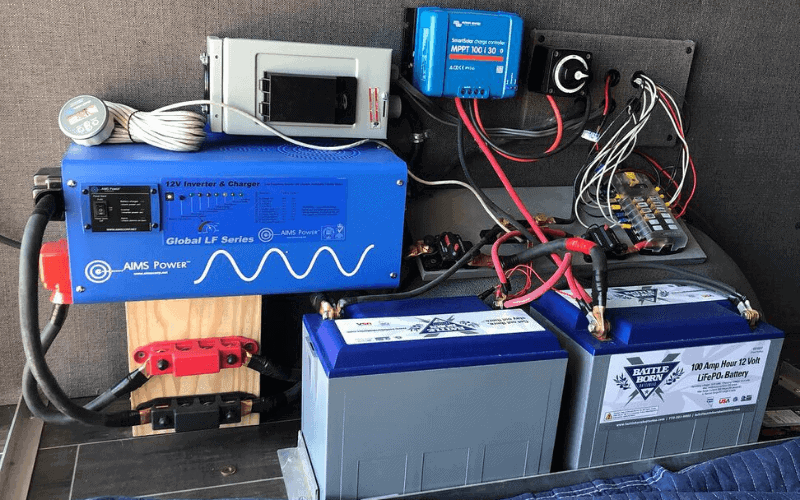
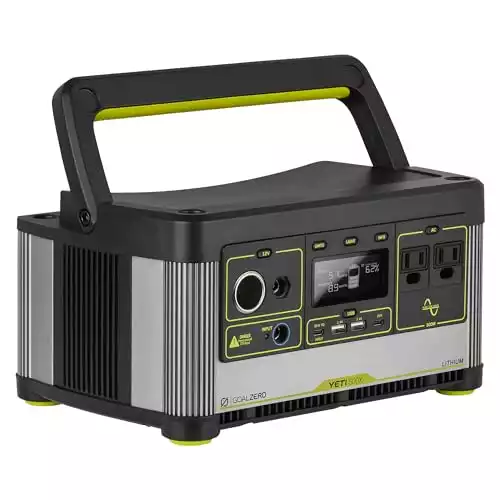
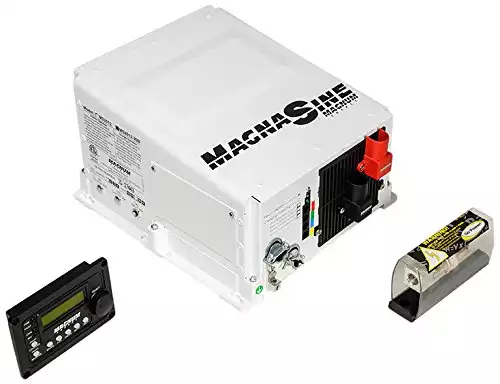
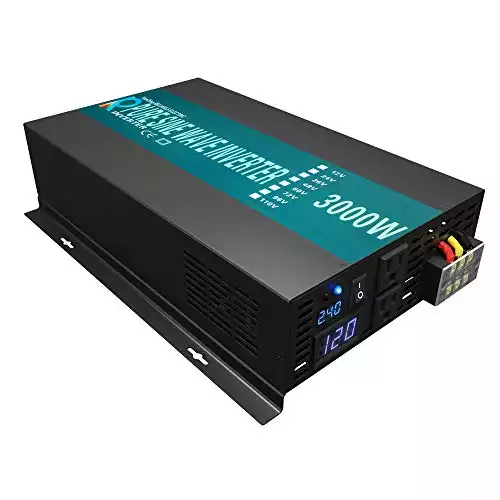
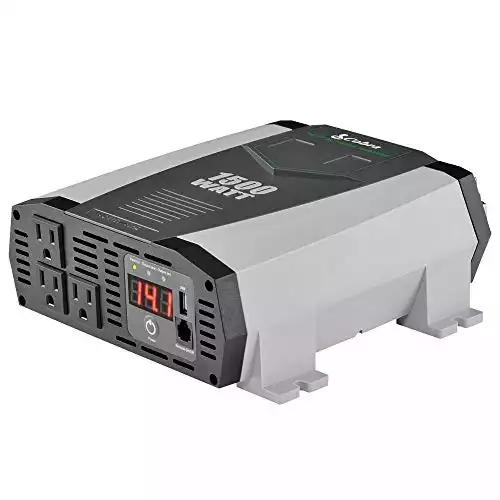
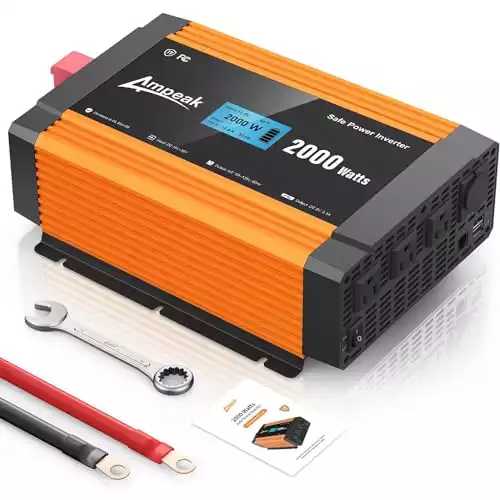
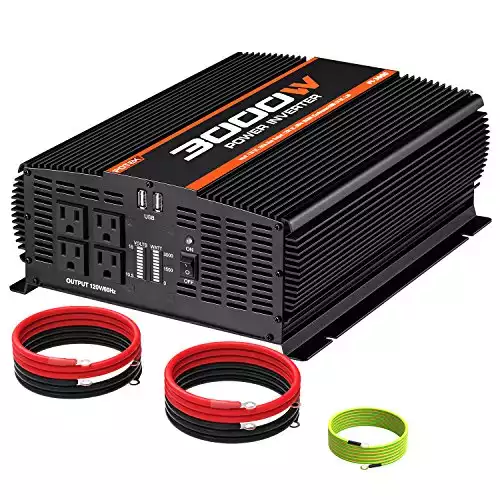
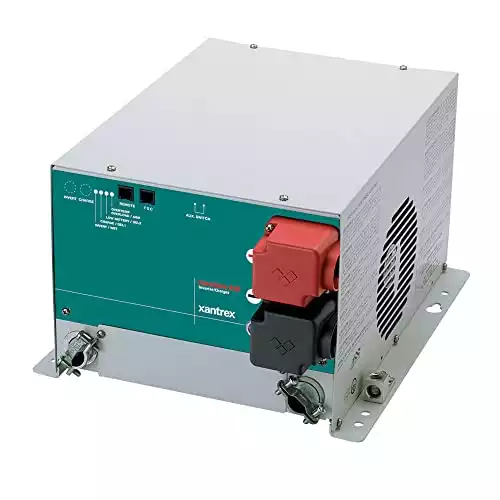
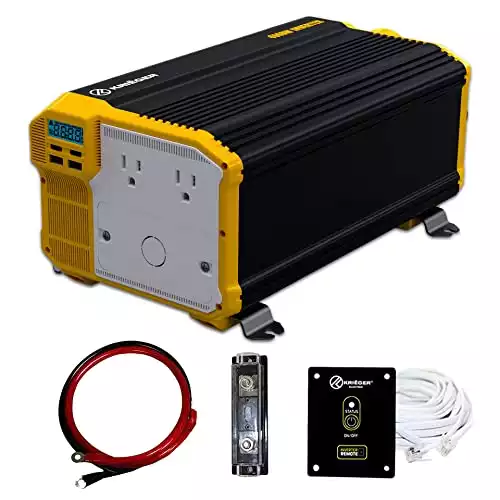
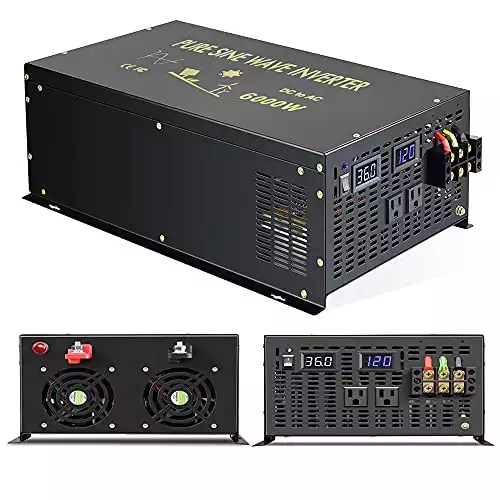
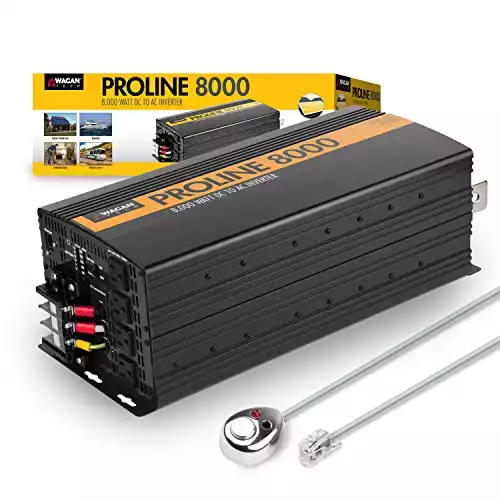
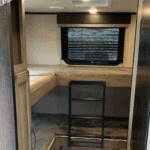


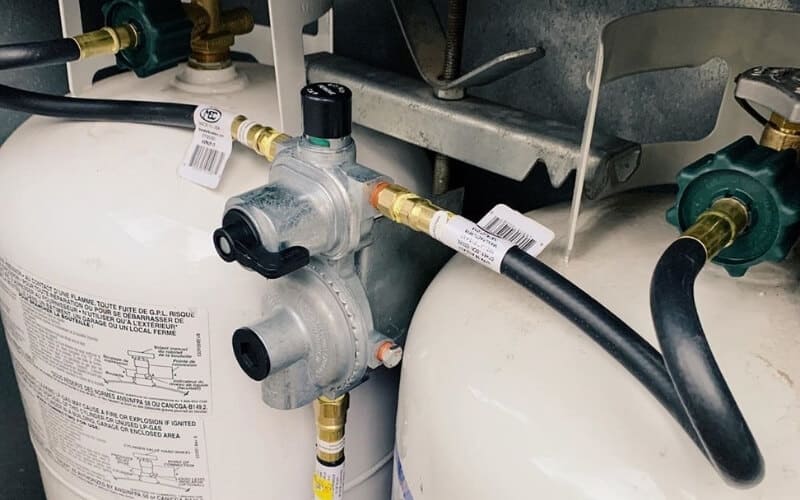
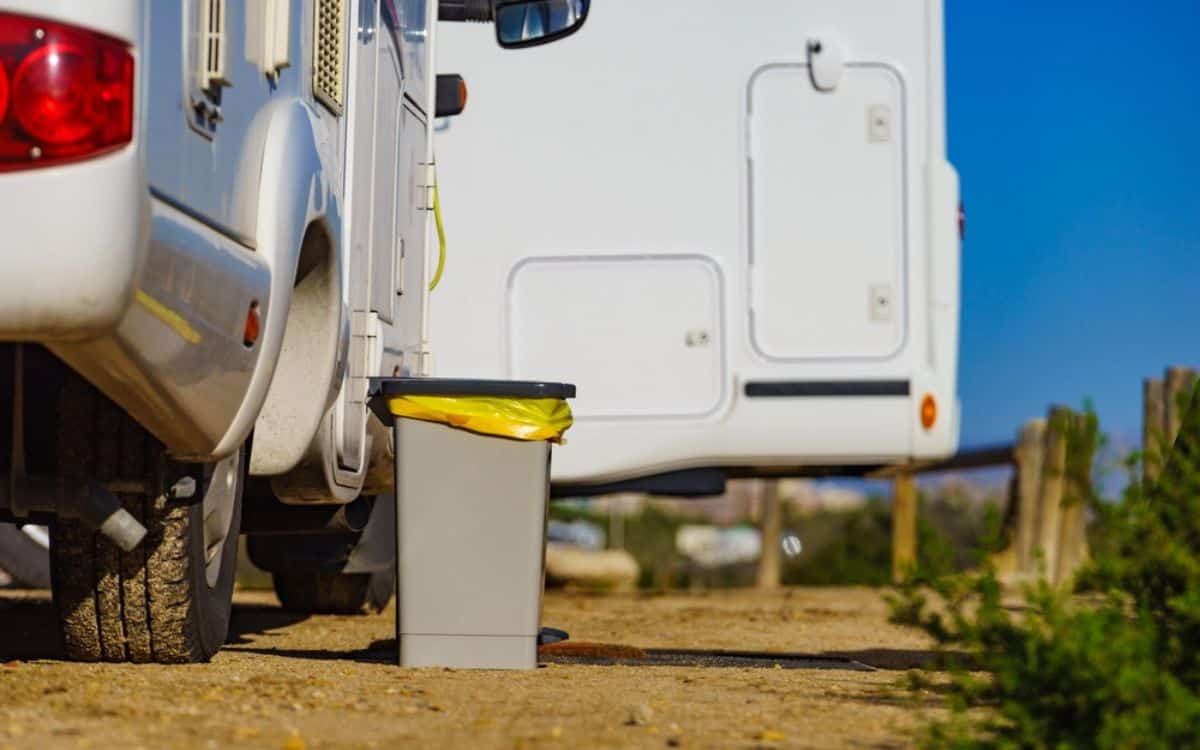
1 Comment
Dalton Bourne
2 years agoI have had an inverter in my 5th wheel and it works as supposed to. I have a question in regards to the inverter. I need to know if neutrals can be tied together without hurting either unit.